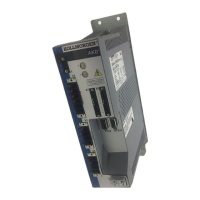8.9.2.4 Discharging KCM modules
The aids supplied with each KCM module (plug-in bridge/connecting cables) allows dis-
charging the modules safely.
When the charging LED on top of the modules flashes, the capacitors are charged. Please
note, however, that the LED does not allow you to draw a definite conclusion about the state
of discharge, as it is not monitored for failures.
DC Bus link terminals in servo systems carry high DC voltage of up to
900 V. Touching the terminals while they are carrying voltage is
extremely dangerous.
Switch off the line voltage (disconnect the system). You must only work
on the connections when the system is disconnected.
Check the state of charge of the capacitors with a measuring device that
is suitable for a DC voltage of up to 1,000 V. Wait until the voltage meas-
ured between the DC+/DC- terminals or to ground has sunk below 40 V.
It can take over an hour for the modules to self-discharge. If you cannot
wait for the duration of the self-discharge time, you must force the mod-
ules to discharge.
You must follow the procedure described below when forcing the mod-
ules to discharge.
For your own safety, proceed as follows when forcing the modules to discharge:
1. Switch off (disconnect) the line voltage.
2. Discharge the modules:
KCM-S/-P: Insert the plug-in bridge in the screw terminals (black-1 to gray-2) on the base
of the modules, wait at least 30 s, leave the plug-in bridge in place (as a means of secur-
ing for transport). Remove the plug-in bridge again before recommissioning.
KCM-E: Bridge the X2/X3 connector with a connecting cable on the top of the module,
wait at least 30 s, leave the connecting cable in place (as a means of securing for trans-
port). Detach the connecting cable and reconnect the KCM-E properly before recom-
missioning.
3. Perform the scheduled task (e.g., cleaning, maintenance, or uninstallation).
AKD Installation | 8 Electrical Installation
Kollmorgen™ | May 2013 99

